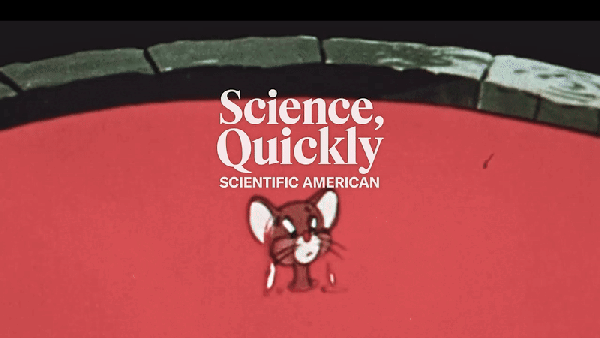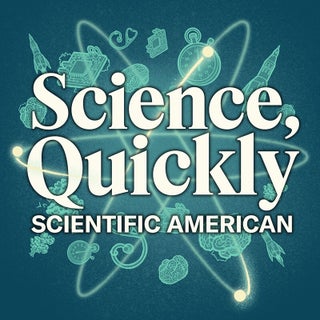[CLIP: Music]
Karen Hopkin: This is Scientific American’s Science, Quickly. I’m Karen Hopkin.
We all have our tricks for sobering up after a night of drunken revelry: maybe a pot of black coffee or an ice-cold shower. But for mice in a certain lab in Texas, all it takes is a shot. No, not more alcohol—it’s an injection of a hormone called fibroblast growth factor 21, or FGF21.
A new study shows that a shot of FGF21—a hormone that regulates metabolic pathways—gets intoxicated mice up and running twice as fast as animals that are allowed to come around on their own.
What’s more, mice lacking FGF21 drink more—and take longer to recover from alcohol’s effects—than their hormonally competent counterparts. The findings appear in the journal Cell Metabolism.
Steve Kliewer: The genesis of this particular project was the finding from several laboratories that this particular hormone that we work on, FGF21, is induced dramatically by ethanol. We wanted to know: "What does FGF21 do acutely in terms of ethanol response to ethanol?”
Hopkin: Steve Kliewer is a professor of molecular biology at the University of Texas Southwestern Medical Center.
Kliewer: I run a lab jointly with this fellow.
David “Davo” Mangelsdorf: And this fellow is David Mangelsdorf. I am a professor and chair of the Department of Pharmacology at U.T. Southwestern and also an investigator of the Howard Hughes Medical Institute.
Hopkin: The two actually met as postdocs at the Salk Institute in San Diego. But after they went their separate ways, they found they often gravitated to the same sorts of questions.
Kliewer: And we ended up publishing a couple of big papers back-to-back during that period....It was a pretty intense competition, right?
Mangelsdorf: Whenever we had a discovery, I was always worried, rightfully so, that Steve’s group also had the same discoveries.
Hopkin: So when Steve joined the faculty at U.T. Southwestern ...
Mangelsdorf: It just made sense to start working together ...
Hopkin: And not just to bask in the academic kumbaya vibes.
Mangelsdorf: I often say that the best way to get rid of your competition is to make them your collaborator.
Kliewer: Asking big questions requires big resources, and doing this makes things more efficient. So I think it just makes sense.
Mengelsdorf: It makes it more fun, to be honest, [to] have somebody that you can throw your ideas off of and not be worried that they’re gonna steal them or something, right?
Hopkin: Okay, where were we? Right, the drunken mice. So a team at the University of Louisville had shown that, in mice, ethanol causes FGF21 levels to soar.
Kliewer: And then our group and other groups showed that this was true not just in mice but also in humans.
Hopkin: They teamed up with a researcher in Austria who gathered a gaggle of young hockey players.
Mangelsdorf: He recruited them to take some shots of vodka over a 30-minute period and monitor their blood levels of FGF21. And he showed that after a couple of shots of vodka, it spiked within just an hour up to four hours. It just stayed very high, higher than anything else that has ever been seen for inducing FGF21 in a human.
Kliewer: So when he originally showed us this data, we didn’t believe him. At least I didn’t believe him. The levels were so high, and nothing like that had been seen in humans. And so that was one of those aha! moments that really grabbed our attention and got us to pivot to really think about FGF21 in the context of ethanol and to focus on that aspect of this hormone.
Hopkin: So as card-carrying molecular biologists, the first thing they did was take some mice and disable the gene for FGF21.
Kliewer: We refer to these as FGF21 knockout mice.
Hopkin: And they gave the knockout mice, as well as genetically unaltered control mice, a binge dose of ethanol.
Mangelsdorf: It would be going to the bar and drinking yourself silly until you are essentially incapacitated.
Hopkin: At that point, the knockout mice and the control mice were all, um, knocked out.
Kliewer: But what we noticed–what was really remarkable and obvious–was that the knockout mice took twice as long to recover consciousness as the control mice.
Hopkin: So when you drink, your liver boosts production of FGF21, a hormone that also governs the body’s response to diet or starvation. That hormone, it turns out, not only helps bring you out of your drunken stupor ...
Mangelsdorf: It sends a signal to the brain that in the animal models, including now in primates, tells you to stop drinking alcohol or suppresses your desire for alcohol.
Kliewer: So it suppresses consumption. It stimulates water consumption to prevent the dehydration. And it acts also on the brain–all of these effects are through the brain–to blunt the effects of intoxication.
Hopkin: So to reiterate, when you take FGF21 away from mice that are on a bender ...
Mangelsdorf: They stay knocked out for twice to three times as long as normal.
Hopkin: So the obvious next question is ...
Mangelsdorf: Well, what happens if you give FGF21 as a drug at a concentration that is way above what would ever be found naturally?
Hopkin: That’s what Steve and Davo—a moniker David inherited in his student days—did next. They took normal mice that had normal levels of the hormone and got them liquored up to the point of oblivion.
Mangelsdorf: You lay them on their back, and they don’t move. They’re just completely out.
Hopkin: Those party animals can be rapidly revived with a shot of FGF21. And the hormone also boosted their motor coordination. So when the researchers treated mice to more moderate doses of hooch ...
Mangelsdorf: This would be the equivalent in a human of somebody who’s too drunk to drive, right? Or even walk a straight line ...
Hopkin: They found that FGF21 restored the animals’ balance in the mouse version of a sobriety test.
Kliewer: We put a mouse on this slowly rotating rod, and we ask them to stay on the rod for 60 seconds.
Hopkin: Sober mice find this test easy-peasy. But given a little tipple ...
Kliewer: They can’t stay on the rod.
Hopkin: FGF21, however, gets them back on their feet—or, in this case, their paws.
Now, booze does more than alter one’s ability to cling to a stick or stand on one leg and recite the alphabet. It can depress your heart rate and breathing.
Kliewer: We’re in the midst of looking at these as well, both in the context of loss of function, the FGF21 knockout mice, and using FGF21 as a drug and seeing if we can promote recovery.
Hopkin: They also plan to analyze one of alcohol’s more regrettable effects.
Kliewer: So decision-making is an important one, and that’s something that we need to do. There are maze types of assays that we can employ and do the same sorts of experiments in which we test the FGF21 knockout mice and see if they are poor performers, and give recombinant FGF21 and see if we can accelerate recovery.
Hopkin: A drug that can reverse alcohol’s myriad effects would be quite a therapeutic prize.
Mangelsdorf: The pharmaceutical industry has been interested in trying to discover amethystic agents in the past ...
Hopkin: “Amethystic” is derived from the Greek word amethustos, meaning ”not drunk.”
Mangelsdorf: Amethyst crystals were believed by the Greeks to cure drunkenness, and what FGF21 essentially is is an amethystic agent ...
Hopkin: One that would be particularly welcome in the ER.
Mangelsdorf: When people come into the emergency room for example, and they’re passed out, the whole goal of the emergency room staff is to wake those people up.
Hopkin: And not just because alcohol poisoning can be fatal.
Mangelsdorf: The other problem is actually an important financial problem, and that is that they have to keep those people in the emergency room until they wake up. They can’t just release them to go home.
Hopkin: Now, FGF21 isn’t a remedy for revelry you can try at home. The hormone has to be administered by injection. Still, the researchers agree that studying this shortcut to sobriety has been a rewarding scientific adventure.
Kliewer: This has been the most exciting project that I’ve worked on in my career—I have to say, the most interesting.
Mangelsdorf: And as scientists, we’re always interested in making a discovery on a new pathway or mechanism, but what makes it particularly, in this case, attractive is that it has a potential therapeutic use that would be phenomenally helpful ….
Hopkin: To which I raise my glass and say, “Amethustos!”
[CLIP: Sound of clinking glasses]
Hopkin: Science, Quickly is produced by Jeff DelViscio and Tulika Bose. Our theme music was composed by Dominic Smith.
Hopkin: Don’t forget to subscribe to Science, Quickly wherever you get your podcasts. For more in-depth science news and features, go to ScientificAmerican.com. And if you like the show, give us a rating or review.
For Science, Quickly, I’m Karen Hopkin.
[CLIP: Music]

